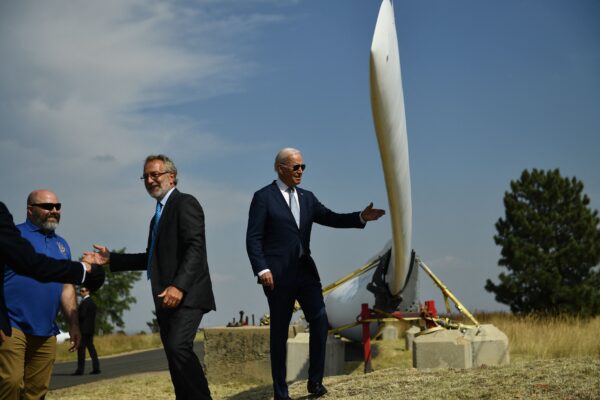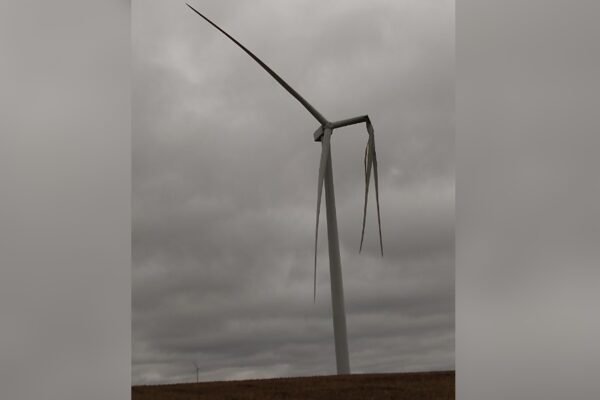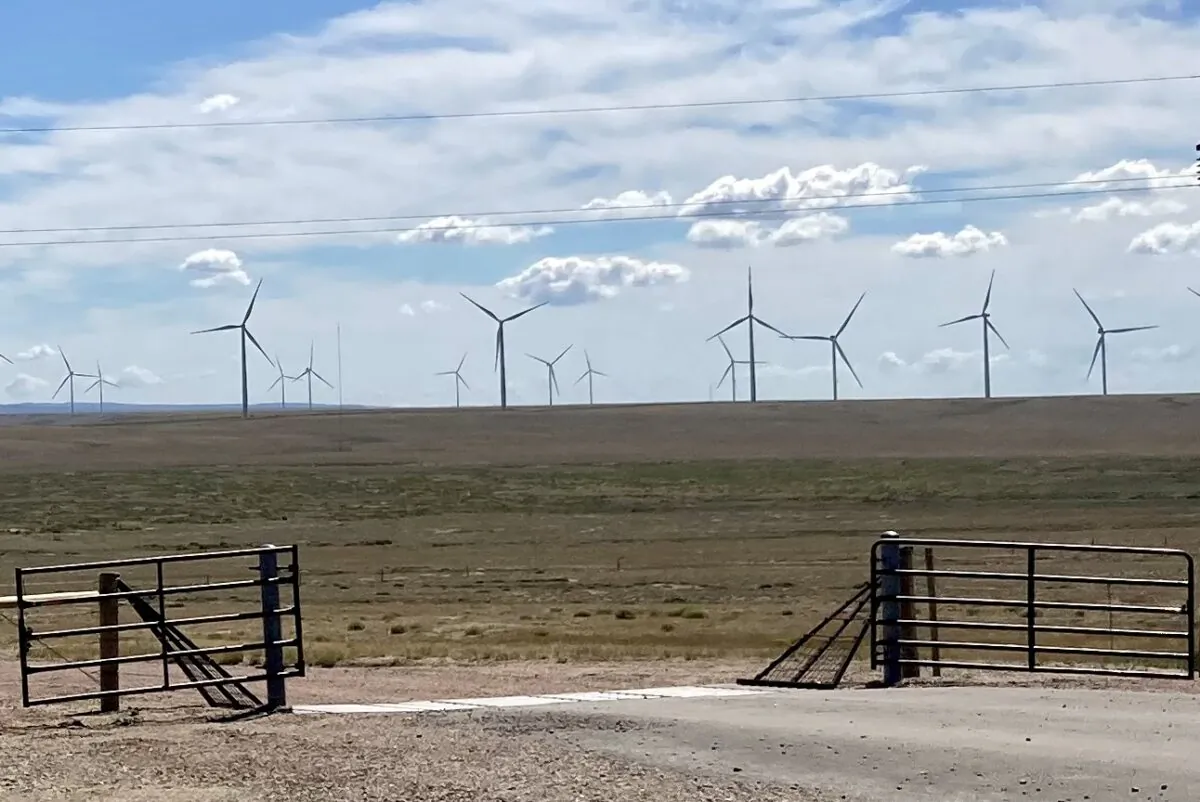A landmark interregional transmission line project has broken ground this week to carry high-voltage electricity 732 miles from the largest wind farm in North America to Nevada.
The TransWest Express Transmission Project (TWE) will take electricity generated by the $5 billion, 3,000 megawatt, 600-turbine Chokecherry and Sierra Madre Wind Energy Project (CSMWE) located in Carbon County, Wyoming, to the Market substation in Eldorado Valley, Nevada, which lies within the largely untouched region of the Mojave Desert.
The line that will run through Colorado and Utah will power California, Nevada, and Arizona.
Though the project—among others that the Biden administration’s incentives have kickstarted—is being celebrated as a new frontier of clean energy to combat climate change, there is a darker side as voiced by environmentalists whose unpopular opinion on the impacts of these projects have been quelled to support a narrative promoting an energy source that may not be as clean as it’s promoted.
“The scope and size of these projects are mind-boggling,” Judy Bundorf, a resident of Southern Nevada, told The Epoch Times. “This will do so much environmental and visual damage, not to mention killing eagles by the hundreds in the Wyoming area.”
In 2008, Bundorf discovered there would be an 87-turbine, 200-megawatt windfarm called the Searchlight Wind Energy Project built near her home in Searchlight, Nevada, surrounded by the Piute-Eldorado Area of Critical Environmental Concern (ACEC) on Bureau of Land Management (BLM) land.
She and the Friends of Searchlight Desert and Mountains (FSDM) and several other plaintiffs began what became a 10-year battle and five-year lawsuit against BLM, the U.S. Department of Interior (DOI), and U.S. Fish and Wildlife Service (FWS) on the grounds that the federal defendants had violated the National Environmental Policy Act (NEPA), the Endangered Species Act (ESA), the Federal Land Policy and Management Act, the Bald and Golden Eagle Protect Act, and the Migratory Bird Treaty Act.
It began with opposition at a local level, with the Searchlight Town Advisory Board voting against the project, a vote which was later overridden by the Clark County Commissioners, Bundorf said.
This brought her, and the FSDM, before the Nevada Public Utilities Commission, which had already greenlighted the project based on BLM’s environmental study concluding the project would not impact wildlife such as golden eagles, desert tortoises, and bats.
As there is today, there were “well-connected special interests and their allies in government” applying political pressure to get the project done, Bundorf said.
In this case, the pressure was handed down from the late former Democrat Sen. Harry Reid, whom she told The Daily Signal in 2016, favored “inefficient and expensive renewable energy plans” that destroy the environment.
In the end, a judge ruled that BLM and FWS had conducted a weak review of the impacts of wind turbines on wildlife and the environment, and the project was abandoned.
‘Under Attack from Solar and Wind Developers’
But now, with the Biden administration’s federal invectives to construct what it has deemed as clean, renewable energy, there may be no more successful David vs. Goliath lawsuits to stop wind turbine and solar industry that is projected to spread across landscapes and ocean fronts throughout the U.S.
“It’s expensive,” Bundorf said, and with the momentum of projects growing exponentially, there’s not much that can stop projects like TransWest Express.
“The whole Southwest is under attack from solar and wind developers,” Bundorf said, which will end with the mystic, quiet solitude of the desert landscape being destroyed by the grinding of industrial development.
The TWE transmission lines, which will run through Colorado and Utah, will provide electricity to California, Nevada, and Arizona, interconnecting with Wyoming’s PacifiCorp system, the Los Angeles Department of Water and Power, Utah’s Intermountain Power Plant systems, and the California Independent System Operator.
The TWE and CSMWE projects—scheduled to come online by 2027—are commissioned by The Anschutz Corporation, owned by Phil Anschutz, a Colorado oil and gas billionaire.
A groundbreaking ceremony took place at Overland Trail Ranch south of Rawlins, Wyoming, on June 20, with U.S. Secretary of Interior Deb Haaland, U.S. Secretary of Energy Jennifer Granholm, TWE President and CEO Bill Miller, and Wyoming Republican Gov. Mark Gordan.
“The TransWest Express Project will accelerate our nation’s transition to a clean energy economy by unlocking renewable resources, creating jobs, lowering costs, and boosting local economies,” said Haaland. “Through historic investments from President Biden’s Investing in America agenda, the Interior Department is helping build modern, resilient climate infrastructure that protects our communities from the worsening impacts of climate change.”
The Obama administration identified the TWE project as a priority as far back as 2011, a DOI press release stated.
“Since then, BLM’s Wyoming office has worked closely with a variety of stakeholders as the lead federal permitting agency to develop the best possible route,” the press release said. “By collaborating closely with partners, the BLM was able to offset project impacts to greater sage-grouse, lands with wilderness characteristics, and other natural resources in Colorado, Nevada, Utah and Wyoming.”
According to the DOI, the construction of wind turbines, transmission lines, and solar panels on public lands is essential to meeting goals laid out by the Biden administration’s plan to attain a carbon pollution-free power grid by 2035, which includes permitting 25 gigawatts of solar, wind, and geothermal production on public lands by 2025.
BLM is currently processing 74 utility-scale onshore clean energy developments proposed on public lands in the western U.S.
“This includes solar, wind and geothermal projects, as well as interconnected gen-tie lines that are vital to clean energy projects proposed on non-federal land,” the DOI said. “These projects have the combined potential to add over 37,000 megawatts of renewable energy to the western electric grid.”
In addition, BLM is reviewing over 150 applications for solar and wind development and 51 applications for wind and solar testing.

‘Visible for Hundreds of Miles’
“You can’t fault anyone for trying to make money, but I’m not sure what people realize what they’re getting into and how long they’ll be staring at these enormous wind turbines with bright lights that will be blinking 24/7,” Bundorf said. “They’re visible for hundreds of miles.”
In the Midwest, landowners have reported contracts with wind energy companies to be imbalanced and one-sided, giving more power to the wind company than the property owner.
Marti Machtan told The Epoch Times in a previous report that wind companies can exit the contract at any time, while landowners must commit to decades worth of encumbrances.
“There are liability shifting provisions for the big multi-billion-dollar multinational companies that shift risks onto these farmers,” he said.
There are also inadequate decommissioning standards, he added.
“One of the things people are worried about is, because this type of energy production really doesn’t make sense over the long term, there’s the risk that farmers are going to be left holding the bag,” Machtan said.
This appears to be what happened in April in Marshall County, Kansas, where a wind turbine broke and scattered fiberglass shards across a farm, ruining a farmer’s crop.
When investigating the issue, Kansas state Rep. Carrie Barth found that industrial wind companies have several loopholes they can take to get out of repairing or decommissioning turbines, leaving property owners stranded with these structures reaching and some even surpassing 700 feet tall.
Ellen Koch reported to The Epoch Times that as of June 23, the turbine “was still swinging in the air,” but that the company said on June 7 that it would be replaced in two weeks.
“It’s been 16 days,” Koch said, adding that fiberglass still covers the ground on which it shattered.

‘It’s Beyond Belief’
Even if the turbines were to be removed when decommissioned, the damage has already been done in the fragile desert ecosystem, Bundorf said.
“When you consider that you can still see the tracks from people traveling to California on wagons, you understand that our environment doesn’t recover that way,” Bundorf said. “The desert Southwest is an extremely sensitive environment. You look at a sagebrush that is maybe two to three feet tall, and it could be hundreds of years old.”
Clean energy companies apply for and have been granted “incidental take permits,” which are used under the U.S. Endangered Species Act to protect these companies from liability when endangered wildlife is harmed.
“To give you an idea of how crazy this is, green-energy companies in California can get take permits to kill California condors,” Bundorf said.
The California condor, the largest North American land bird, became extinct in the wild in 1987 but has since been reintroduced into its natural habitats in Utah and Arizona.
The desert tortoise is another species that faces a reduction in population because of the construction.
“Theoretically, you could pick them up and move them before they bulldoze, but they live underground,” Bundorf said.
Since they can’t locate them all, many of them are killed, she said.
“It’s beyond belief,” Bundorf said. “I think in 20 years will look back on this and say this was the craziest thing we’ve ever done to generate energy.”

